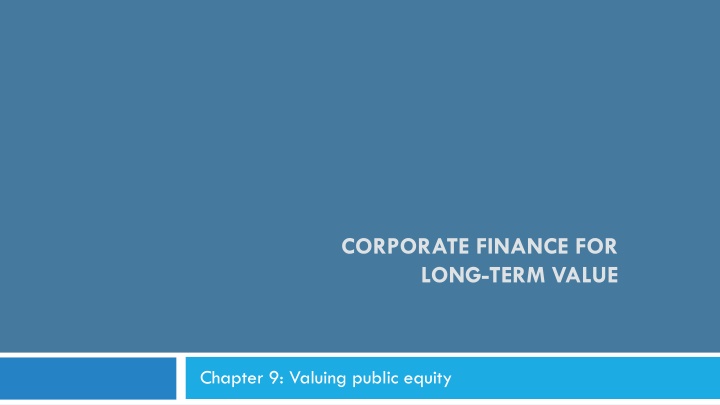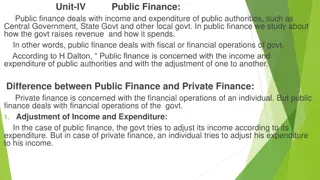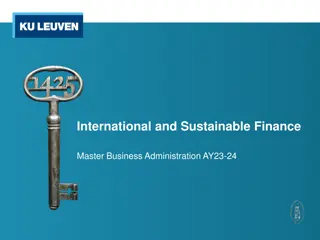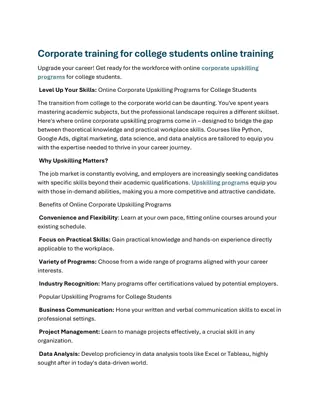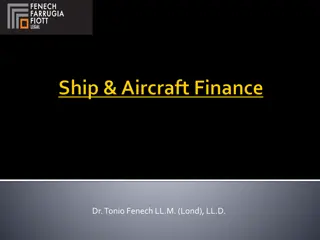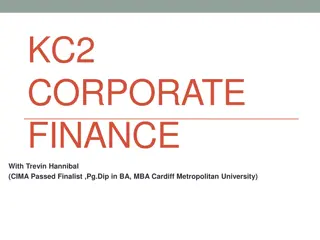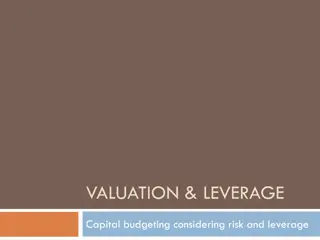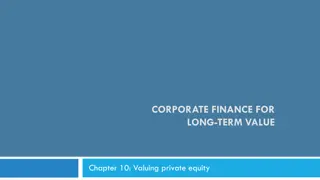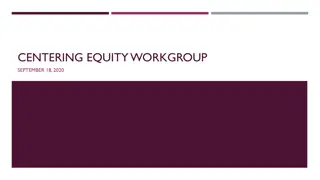Valuing Public Equity in Corporate Finance
This chapter delves into the essential aspects of valuing public equity in corporate finance, providing insights into techniques and strategies to determine the worth of publicly-traded stocks. From understanding market dynamics to evaluating financial performance, the chapter equips readers with a comprehensive understanding of valuing public equity for long-term value creation.
Download Presentation

Please find below an Image/Link to download the presentation.
The content on the website is provided AS IS for your information and personal use only. It may not be sold, licensed, or shared on other websites without obtaining consent from the author.If you encounter any issues during the download, it is possible that the publisher has removed the file from their server.
You are allowed to download the files provided on this website for personal or commercial use, subject to the condition that they are used lawfully. All files are the property of their respective owners.
The content on the website is provided AS IS for your information and personal use only. It may not be sold, licensed, or shared on other websites without obtaining consent from the author.
E N D
Presentation Transcript
CORPORATE FINANCE FOR LONG-TERM VALUE Chapter 9: Valuing public equity
Part 3: Valuation of companies Chapter 9: Valuing public equity
The BIG Picture 3 Company valuation is at the core of corporate finance Listed companies are traded (and valued) in financial markets Different methods While relative valuation methods rely on market metrics and efficient markets, absolute valuation brings a deeper (fundamental) understanding of companies Key is to assess a company s value drivers Fundamental methods are most suited for integrating S & E factors into equity valuation
The public equity (or stock) market 4 Global stock markets reached a market capitalisation of $106 trillion in 2021, which is about 125% of global GDP The joint stock company allows for the spreading of risk across many shareholders with residual claims and limited liability Most suitable for sustainability integration Classification of investment types: Fundamental choice of business fundamentals Private Active investing: based on fundamental or quantitative analysis of the company Equities Quant choice of quant factors Public Passive investing: through indices or ETFs (Exchange Traded Funds) Passive choice of index
Allocation role 5 Trading in stock markets facilitates price discovery Puzzle of passive vs active investing Passive investing limits cost of analysis and trading (active investing adds 70bps), but also limits scope for societal allocation role of finance You need a minimum amount of active traders to get news into stock market prices (the so-called process of price discovery) What is appropriate balance between passive and active investing?
Stock markets 6 Primary stock markets New issues of stock are issued to investors A firm s initial public offering (IPO) is their first listing on a stock exchange Secondary stock markets Previously traded equities are traded again If a firm sells new stock on an exchange, this is called a seasoned equity offering (SEO) or secondary public offering (SPO)
Initial Public Offerings (IPOs) 7 Disadvantages of IPOs: Motives for IPOs: To obtain funds to finance investments Expensive procedure due to underwriters commission, legal fees, etc. Increased financial autonomy due to becoming less dependent on a single financial provider Creates a larger gap between external Diversifies investment risk of owners investors and managers, which could lead to more agency problems Increased recognition of company name Increased exposure to scrutiny of Better information and transparency due to shareholders focused on short-term gain disclosure requirements Stock acts as disciplining mechanism for managers
Equity valuation 8 Abbreviations V Value Absolue valuation ???1 ???2 ????+ ?? (1 + ????)? FCF Free cash flow ?0= (1 + ????)+ (1 + ????)2+...+ WACC Weighted average cost of capital ? = ??? ? Relative valuation P Stock price ? EPS Earnings per share E Earnings
Equity valuation 9 Absolute valuation methods Based on the company s cash flows, which are forecasted and then discounted at company s discount rate Three main value drivers Sales, which are composed into volumes and price Margins, which are analysed by type of costs and before or after depreciation, taxes and interest paid (EBIT) Capital, which is split into the cost of capital (discount rate) and the uses of capital (capex, working capital) Question what is more important for valuation cash flows or discount rate? Academics discount rate (capital) Practitioners cash flows (sales and margins)
Enterprise value 10 The enterprise value is the market value of the company s underlying business before financing by equity and debt, and separate from any cash ?0= ??????0+ ????0 ??? 0 It provides a comprehensive overview of the company s business activities, which helps to focus on a company s long-term value It highlights which activities contribute and negatively impact a company s future value, which can aid the company in its strategy setting
Dividend-discount model 11 The dividend discount-model looks at cash flows to equity investors First, the cash flow of the dividend received Second, the cash flow from the sale of the stock at a future date Equation for stock price: ?0=???1+?1 1+??, where: ???1is the net present value of dividends received during the year ?1is the stock price at the end of the year ??is the cost of equity, which is the expected return of other investments in the market with similar risks Dividend yield Rewriting the formula: ??=???1+?1 1 =???1 ?0+?1 ?0 Capital gain ?0 ?0
Multi-year dividend-discount model 12 The stock price is equal to the present value of the expected dividends Assuming a constant dividend growth ?, we get the following: (1+??)2 +???1 (1+?)2 ???1 (1+?)? 1 1+?? ???1 (1+??)+???1 (1+?) ?0= + = ? (1+??)3 ?=1 If an investor receives growing dividends into perpetuity, the equation becomes: ?0=???1 ?? ? Constant dividend growth model
Dividend payout ratio 13 The actual dividend depends on the payout ratio: Earnings? ????= Shares outstanding? dividend payout ratio?= ???? dividend payout ratio? ????= earnings per share An updated dividend-growth model includes share repurchases ?0=?? (total dividends and share repurchases) Shares outstanding0 Share repurchases are exempt of dividend tax, and are thus an efficient way of rewarding shareholders The equity value is the present value of total dividends and share repurchases ??????0= ?? (total dividends and share repurchases)
The discounted cash flow (DCF) model 14 The DCF model values a company s assets based on their discounted future cash flows The starting point is the earnings before interest and taxes EBIT The company must pay corporate tax ? on these earnings Deduct net investment (????? depreciation) and increases in net working capital ??? The free cash flow ??? of the company is: FCF = EBIT (1 tax rate) ????? + depreciation increases in ???
Free cash flows (FCF) 15 Free cash flows are to be distributed to financiers after all positive ??? investments have been done Use FCF instead of earnings, since earnings can be easily manipulated (i.e. through accruals and depreciation) Accruals are differences between net earnings and operational cash flow, where cash has not changed hands A company can increase depreciation to reduce (taxable) profits or decrease depreciation to show higher book profits to investors
Weighted average cost of capital 16 The free cash flows can be discounted to obtain the enterprise / company value ?0at ? = 0: ???1 (1 + ????)2+...+????+ ??? ???2 ?0= (1 + ????)+ (1 + ????)? ???? is the weighted average cost of capital, which is the rate of return demanded by the company s financiers (of both equity and debt) In the case of constant growth g: ???1 ???? ? ????+1 ???? ? ?0= ???= Same formula used to determine the terminal value
Assumptions in the DCF model 17 A ??? valuation crucially relies on assumptions to be made on future ??? and on the cost of capital ???? Behavioural problem: analysts often extrapolate historical numbers into infinity Having determined a company s enterprise value ?0, the stock price ?0 can be determined as follows: ?0=?0 ????0+ ??? 0 Shares outstanding0= ??????0 Shares outstanding0
DCF example 18 WACC FY2019 6% 11% 20% 6% 6% 9% 8% TV growth FY 2022 7% 12% 29% 5% 6% 8% 2% 1/1/18 FY 2020 11% 12% 21% 5% 6% 9% FY 2021 6% 12% 30% 5% 6% 9% 2023e 6% 12% 28% 5% 6% 8% 2024e 6% 12% 28% 5% 6% 8% 2025e 6% 12% 28% 5% 6% 8% 2026e 6% 12% 28% 5% 6% 8% 2027e 6% 12% 28% 5% 6% 8% 2028e 6% 12% 28% 5% 6% 8% 2029e 6% 12% 28% 5% 6% 8% 2030e 6% 12% 28% 5% 6% 8% 2031e 2% 12% 28% 5% 5% 8% Sales growth EBIT margin Tax rate Depreciation/sales CAPEX/sales NWC/sales Sales EBIT Taxes on EBIT NOPLAT Depreciation Gross CF CAPEX increase in NWC Gross investment FCF 6233 691 138 553 361 914 399 37 436 478 6910 807 172 635 377 1012 430 33 463 549 7348 906 276 630 352 982 458 32 490 492 7856 937 269 668 405 1073 472 28 500 573 8327 993 278 715 416 1131 500 40 539 592 8827 1053 295 758 441 1199 530 42 572 628 9357 1116 312 804 468 1271 561 44 606 666 9918 1183 331 852 496 1348 595 47 642 705 10513 1254 351 903 526 1428 631 50 681 748 11144 1329 372 957 557 1514 669 53 722 793 11813 1409 394 1014 591 1605 709 56 765 840 12521 1493 418 1075 626 1701 751 59 811 891 12772 1523 427 1097 639 1735 639 21 660 1076 17930 8 0.540 9685 70% ?????? = net operating profit less adjusted taxes Terminal Value (TV) period, in years Discount Factor Present Value 1 2 3 4 5 6 7 8 0.926 549 13798 1328 12470 213 58.5 60.2 -3% 699 4424 17% 0.858 538 0.794 528 0.735 519 0.681 509 0.630 499 0.583 490 0.540 481 TV/V Sum of Present Values: Enterprise Value (V) Net debt Equity value ?????? Number of shares outstanding ???? = ????? depreciation + ??? Stock price Current stock price Implied upside 631 4206 15% Net Working Capital (NWC) Invested Capital ROIC 566 3982 14% 599 4068 16% 659 4301 16% 740 4554 17% 785 4692 18% 832 4838 18% 882 4993 19% 935 5158 19% 991 5332 20% 1050 5517 20% 1071 5538 20% ???? = return on invested capital
DCF equity valuation changed EBIT (previously 12%) 19 WACC FY2014 6% 11% 20% 6% 6% 9% 8% TV growth FY 2017 7% 12% 29% 5% 6% 8% 2% 1-1-2018 FY 2015 11% 12% 21% 5% 6% 9% FY 2016 6% 12% 30% 5% 6% 9% 2018e 6% 12% 28% 5% 6% 8% 2019e 6% 13% 28% 5% 6% 8% 2020e 6% 14% 28% 5% 6% 8% 2021e 6% 15% 28% 5% 6% 8% 2022e 6% 16% 28% 5% 6% 8% 2023e 6% 16% 28% 5% 6% 8% 2024e 6% 16% 28% 5% 6% 8% 2025e 6% 16% 28% 5% 6% 8% 2026e 2% 16% 28% 5% 5% 8% Sales growth EBIT margin Tax rate Depreciation/sales CAPEX/sales NWC/sales Sales EBIT Taxes on EBIT NOPLAT Depreciation Gross CF CAPEX increase in NWC Gross investment FCF 6233 691 138 553 361 914 399 37 436 270 6910 807 172 635 377 1012 430 33 463 751 7348 906 276 630 352 982 458 32 490 1022 Terminal Value (TV) period, in years Discount Factor Present Value 7856 937 269 668 405 1073 472 28 500 1473 8327 993 278 715 416 1131 500 40 539 592 8827 1148 321 826 441 1268 530 42 572 696 9357 1310 367 943 468 1411 561 44 606 805 9918 1488 417 1071 496 1567 595 47 642 925 10513 1682 471 1211 526 1737 631 50 681 1056 11144 1783 499 1284 557 1841 669 53 722 1119 11813 1890 529 1361 591 1951 709 56 765 1187 12521 2003 561 1442 626 2069 751 59 811 1258 12772 2043 572 1471 639 2110 639 21 660 1450 24172 8 0.540 13056 71% 1 2 3 4 5 6 7 8 0.926 549 18317 1328 16989 213 79.8 60.2 32% 699 4424 17% 0.858 597 0.794 639 0.735 680 0.681 719 0.630 705 0.583 692 0.540 679 CV/EV Sum of Present Values: Enterprise Value (EV) Net debt Equity value Number of shares outstanding Stock price Current stock price Implied upside 631 4206 15% Net Working Capital (NWC) Invested Capital ROIC 566 3982 14% 599 4068 16% 659 4301 16% 740 4554 19% 785 4692 21% 832 4838 23% 882 4993 25% 935 5158 26% 991 5332 26% 1050 5517 27% 1071 5538 27%
Sensitivity analysis 20 A sensitivity analysis shows that under reasonable assumptions the stock price can fluctuate between a range Using DCF, Adidas stock price is 301.20 (based on 9% growth + 13% EBIT) In the table below, assuming a ranging sales growth between 7% and 11% and EBIT margin between 11% and 15%, Adidas stock price can reasonably fluctuate between 227.60 and 385.50 Sales growth 7% 8% 9% 10% 262.8 289.2 315.5 341.9 368.3 11% 275.4 302.9 330.4 357.9 385.5 11% 12% 13% 14% 15% 227.6 250.7 273.9 297.1 320.2 238.9 263.1 278.3 311.5 335.7 250.7 275.9 301.2 326.4 351.7 EBIT margin
Comparing absolute valuation methods 21 Determines the Value Present value of Stock price Dividend payments per share ?0 Total payouts (total dividends and share repurchases) Equity value ??????0 Enterprise value Free cash flow (cash available to equity and debt holders) ?0
Equity value multiples 22 In relative (or multiples) valuation, a stock value ?0is derived from the given value of another comparable stock Peer group s P/E ratio ?0= ???0 ? ? Company s EPS A disadvantage of using the P/E ratio is that a company s current earnings can be distorted use forward P/E ratio instead, which are the expected earnings over the next year Other method is the market price to book value ratio P/B, although this ratio fluctuates considerably making it imprecise and less reliable compared to P/E
Enterprise value multiples 23 To compare companies with different leverage, multiples can be based on a company s enterprise value ?, as this is the value before financing Indicator of earnings before payment to financiers: EBIT (Earnings Before Interest and Taxes) Indicator of earnings before payment to financiers and investments: EBITDA (Earnings Before Interest, Taxes, Depreciation and Amortization) ? Enterprise value ?0multiples formula: ?0= ??????0 Peer group s enterprise value / EBITDA ?????? Company s EBITDA
Integrating sustainability into value drivers 24 Adjusting value drivers on material sustainability issues allows for integration of sustainability into enterprise valuation The value-driver adjustment provides the inward perspective on sustainability and is financially driven Dependencies: inward Business & financial value Society & nature Internalisation rate Impacts: outward
Value driver adjustment (VDA) approach 25 Schramade s (2016) Value Driver Adjustment (VDA) approach splits enterprise valuation into value drivers: Sales, composed into volumes and price Margins, analysed by type of costs and before or after depreciation, taxes, and interest paid Capital, split into the cost of capital (discount rate) and the uses of capital (capex, working capital) VDA approach highlights the company s sources of competitive advantage
Value driver adjustment (VDA) approach 26 Three-step approach: Identify and focus on the most material issues 1. Perform materiality analysis of the industry Plotting likelihood of impact of each issue against its likely size Analyse the impact of these material factors on the individual company 2. Assess company performance on material sustainability issues, both on absolute basis and relative to peers Quantify competitive advantages to adjust for value driver assumptions 3. Make deliberate adjustments to value drivers based on company s competitive (dis)advantages on material sustainability issues
Example VDA approach for medical company 27 Medical company assessed by analyst Material issues: for industry - innovation, human capital, energy, circular economy Performance: medtech s strengths - innovation, human capital & capital management Value driver adjustments: sales +100bps; margins +200bps; capital 0bps (see table) Net result: increase in target stock price from 39.3 to 48.1 (see table) Value driver Sales growth Margins Cost of capital Target price Benchmark (performance excluding sustainability advantage) 4% 13% 8% 39.3 Innovation and circularity/energy savings: +200bps Impact from sustainability factors Innovation: +100bps No impact: 0bps 8.8 (22% higher value) Total 5% 15% 8% 48.1
Examples of value drivers 28 Novozymes Mining company Valuation Valuation Sales growth Margins Capital Sales growth Margins Capital Innovation Production volume Price Human capital Management of local stakeholders Environmental management
Integrated value calculation 29 Graph shows IV and its Integrated value components: FV, EV, SV FV: enterprise value EV SV Negative values of S and E Components of E x their price Components of S x their price Equity Debt raise risk of both debt and 40 equity 30 20 S and E factors can be 10 0 EV+ EV- SV+ SV- Debt Equity internalised and spill over -10 -20 into financial value -30 -40
Case-studies integrated value calculation 30 Case-studies integrated value Value Inditex IV calculation (Euro billions) Ch6-7 project valuation 79 FV (enterprise value) Ch11 company valuation Inditex 283 Positive SV Make DCF for enterprise value FV -137 Negative SV Make DCF for SV + EV -183 Negative EV Integrate numbers 42 IV (integrated value) Ch18 attempted take-over of Unilever by Kraft Heinz
Conclusions 31 To obtain a company s value, equity valuations either: Look at a company s fundamentals using absolute valuation models (e.g. DCF) Compare a company to a similar company using relative valuation models (e.g. P/E ratio) As residual claimholders, equity investors have strong incentives to help companies achieve the conditions for integrated value creation Fundamental valuation methods - through a deeper understanding of a company s value drivers are most suited to sustainability integration
